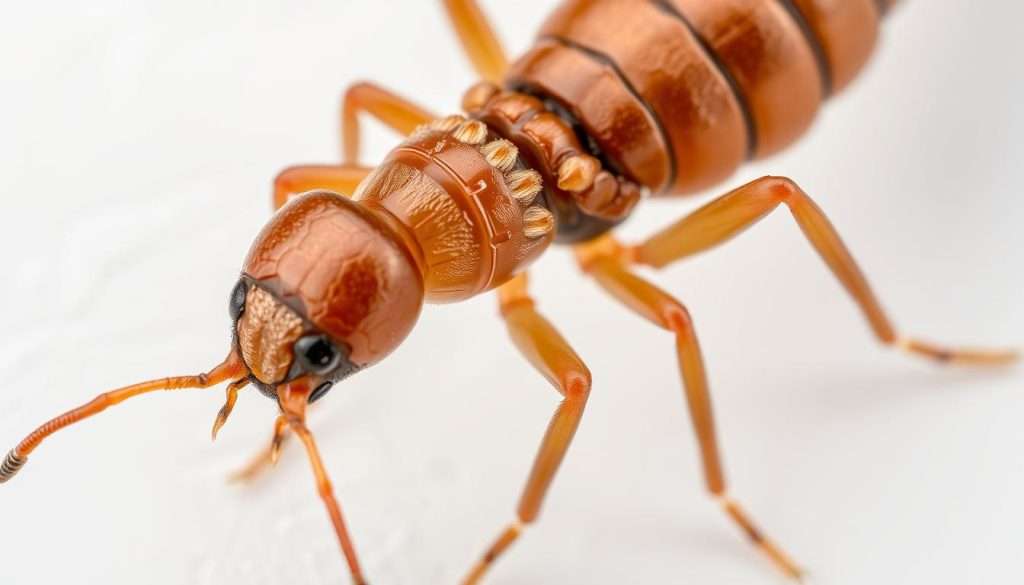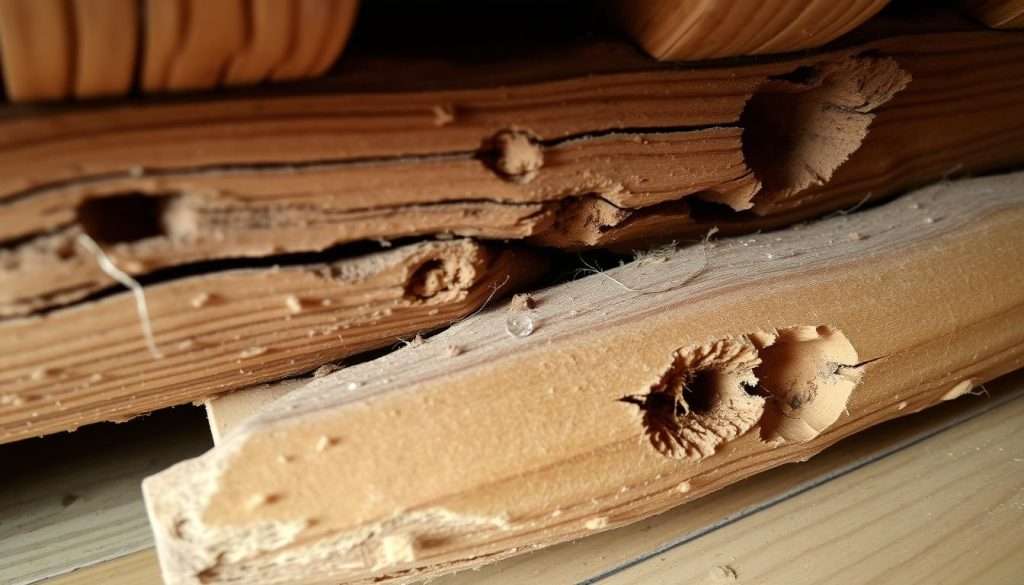Termites are called “silent destroyers” because they damage buildings without being seen. They cause about $5 billion in damage each year. It’s important to know what termites look like to protect your home.
This guide will help you spot termites. We’ll look at their body shape, colors, and types. With over 2,000 termite species, knowing how to identify them is key to stopping infestations.
We want to give you the info you need to spot termites. Let’s explore their features!
Key Takeaways
- Understanding what termites look like is essential to prevent structural damage.
- Termites are known as “silent destroyers” due to their hidden behavior.
- Identifying the features of termites can help you distinguish them from other pests.
- There are approximately 2,000 species of termites around the world.
- Early detection of a termite infestation can save homeowners significant repair costs.
- Termite damage may go unnoticed but can accumulate to huge financial losses over time.
Introduction to Termites
Termites are fascinating social insects. They have complex colonies and affect both nature and human homes. They live in warm, subtropical areas and help break down organic matter. But, they also cause a lot of damage to buildings.
Every year, termites damage over $5 billion worth of property in the United States. Knowing what termites look like and how they behave is key. This knowledge helps prevent big problems.
There are over 2,300 termite species worldwide. Termites can be from 1/8 inch to 1 inch long. Worker termites are soft and pale, while soldier termites have big heads and strong jaws.
Some termites grow wings, making them look like flying ants. But, termites have straight antennae and two pairs of wings. This makes them different from ants.
Subterranean termites can have thousands of swarmers during mating. They live in damp soil and make mud tunnels. Drywood termites live in wood and make tunnels as they eat it.
Knowing the differences between these termites is important. It helps in managing pests better.
What Do Termites Look Like
Knowing what termites look like helps us spot them. They have a special body shape, colors, and sizes. These features help us tell them apart.
Body Structure of Termites
Termites have a thick, tube-like body with straight antennae. They don’t have a clear waist like ants do. This makes their body look smooth and even.
Color Variations Among Species
Termites come in many colors, depending on their type and role. They can be light cream to dark brown or even black. Worker termites are usually lighter, while the reproductive ones are darker.
Size Range of Different Termite Types
Termites vary in size. Worker termites are 1/4 to 3/8 inches long. Reproductive termites can grow up to 1 inch. Knowing these sizes helps us identify them better. For more info, check this identification guide.

Distinct Features for Termite Identification
It’s key to know the special traits of termites to spot them right. Looking closely at details helps tell termites apart from other pests. We’ll check out three main points: termite antennae, wing structure, and caste differences.
Termite Antennae Characteristics
Termites have straight, beaded antennae that often hang down. This is different from ants, which have bent antennae. Spotting this difference helps identify them easily.
Wing Structure of Termites
Termites have wings that are the same size. This is unlike ants, which have longer front wings. This wing symmetry is important for identifying termites when they swarm.
Termite Caste Differences
Knowing about termite castes is crucial for correct identification. A colony has three main castes: workers, soldiers, and reproductives. Each caste has its own special traits:
- Workers: They don’t have wings and forage for food.
- Soldiers: They have big mandibles for defending the colony.
- Reproductives: They include winged swarmers, key for growing the colony.
Spotting these castes helps figure out how bad an infestation is and what to do about it.
Common Termite Species
Knowing about different termite types is key to fighting pests. Each type has its own traits, habits, and homes. This info helps homeowners stop infestations early.
Subterranean Termites
Subterranean termites are common in the U.S. They live in underground nests and make mud tubes to get to wood. They can do a lot of damage, so it’s important to watch out.
Their colonies can have thousands of termites. Eastern subterranean termites are especially bad for homes and buildings.
Drywood Termites
Drywood termites live in the wood they eat, without needing soil. They make small holes to throw out wood from their nests. This makes them easy to spot.
They like dry wood, like wood in attics or exposed timbers.
Formosan Termites
Formosan termites are very aggressive and can damage a lot quickly. They live in warm places like Alabama, Florida, California, and Texas. Their colonies can be huge, with thousands of termites.
They can find and use moisture to get into homes fast.
Dampwood Termites
Dampwood termites need a lot of moisture to live. They like to eat decaying wood. They are less common in buildings because of their need for moisture.
They are bigger than other termites, with dark heads and tan bellies. Watch for moisture to keep them away.
Comparing Termites with Similar Pests
It’s important to know the difference between termites and flying ants. They look similar in the spring. Knowing how to tell them apart can save you money on pest control.
Termites vs. Flying Ants
Here are some key differences:
- Body Shape: Termites have a straight waist. Flying ants have a pinched waist.
- Antennae: Termites have straight antennae. Flying ants have bent ones.
- Wing Size: Termites have wings of the same length. Flying ants have longer front wings.
- Size: Termites are ¼ inch to ½ inch long. Carpenter ants are 9.5 to 13 millimeters long.
Key Identification Differences
Knowing these termite identification differences helps with pest control:
| Characteristic | Termites | Flying Ants |
|---|---|---|
| Body Shape | Straight waist | Pinched waist |
| Antennae | Straight | Two bent |
| Wing Structure | Equal-sized wings | Front wings longer |
| Color | Brown, white, black | Reddish-brown to black |
| Size | ¼ inch to ½ inch | 9.5 to 13 millimeters |
Signs of a Termite Infestation
Spotting termite signs early can save you a lot of trouble and money. It’s key for homeowners to stay alert. Termites can hide for a long time, causing a lot of damage before you see them. There are several signs that show they’re in your home.
Visible Damage and Wood Characteristics
Look for damage signs around your home. This includes:
- Hollow-sounding wood: Tap on wooden parts to see if they sound hollow, which means damage inside.
- Sagging floors or roof: If your floors or roof start to sag, it could be termite damage.
- Mud tubes: Find pencil-thin tubes on walls, foundations, and near insulation. They help termites get to wood.
- Droppings: Drywood termites leave small, uniform pellets on surfaces.
- Shelter tubes: Look for tubes on your home’s outside. Termites use them for protection.
Behavioral Signs to Watch For
Watch for certain behaviors that might mean termites are around:
- Clicking sounds: Soldier termites make these sounds to talk to each other. It means a colony is close.
- Swarming activity: In spring or fall, seeing small piles of wings or swarmers means a colony is nearby.
- Structural changes: If doors and windows seem to shift on their own, it could be termites at work.

Knowing these termite signs is very important. Spotting them early can help you avoid big damage and expensive fixes.
Conclusion
Knowing how to spot termites is key for homeowners to keep their homes safe. By understanding what termites look like, you can stop damage early. Look out for their unique features, sizes, and types.
Termites can be pale or dark, depending on the type. Spotting these differences helps protect your home. It’s the first step in keeping your house safe.
Knowing the signs of termites, like wood damage and frass, helps you stay alert. Termite colonies can have thousands of termites. So, it’s important to act fast if you see any signs.
This guide helps you keep your home safe from termites. With over 2,800 termite species worldwide, knowing the difference is vital. By learning how to identify termites, you keep your home safe from infestations.
